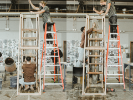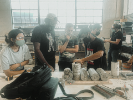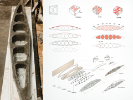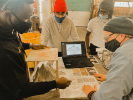Structurosity

Students working with force loads with hands-on learning methods.
Published January 19, 2023
The School of Architecture and Planning offers a myriad of courses under the label of "Structures." Structures is a set of applied physics courses that have transitioned from the traditional lecture heavy, math-based learning to lab-based learning within the Fabrication Workshop, a 5,000-square-foot workspace equipped with tools and technology to help students broaden their fabrication skills.
These courses are taken at the sophomore and junior level, with the final course taught at the graduate level. The courses are interdisciplinary, with 30-40 percent of the class composed of students from external majors, such as Environmental Design. Structures I and III focus more heavily on critical thinking skills and design workshops, while Structures II dives deeper into system mechanics, using tools like Karamba3D, a parametric structural engineering tool which provides accurate analysis of spatial trusses, frames and shells, for analysis work. Topics of discussion are often reinforced by the class being co-taught by an architect and engineer. Structures III works to blend hands-on critical thinking skills with analysis tools like Karamba3D.
During the 2020-21 academic year, Structures began to look more intensely into the materials it teaches, and those who are experts in their use. Structures I focused on wooden elements, load paths, and other fundamental components of design. Structures II centered on steel as a material and introduces technological analysis techniques, and Structures III centered on composite structures, where students make materials from other raw materials with an emphasis on concrete. As students became more comfortable with the ideology of structures, they learned to push the boundaries of each of these materials, both at the smaller scale of the material composition and hands-on modeling, and in how they choose to incorporate these materials into their studio work outside the course
As the academic year progressed, the Structures teaching teams worked to explore and integrate an interdisciplinary approach into the classes. Students this year have learned to develop a more intrinsic appreciation of those working in the fields of construction, masonry, manufacturing and engineering by nature of their hands-on coursework.
The courses often offer multiple site visits to foundries, mills and factories encouraging students to venture off campus to ask questions of the professionals who work with these materials and grow their understanding of the construction process.
Students learn about instances of architects and engineers working together to push the boundaries of structures and their material capabilities. These courses encourage students to do the same. The formatting of the classes allows students to test their own intuition and learn from failure, increasing their confidence in design.
To close the semester, students present their ideas to professionals and discuss how to improve their projects.
Students
Students of ARC 352/552, ARC 453/553, ARC 455/555
Faculty
Christopher Romano (Structures I, III, coordinator), Randy Fernando (Structures I,III), Michael Hoover (Structures I, III), Bonghwan Kim (Structures II), Jin Young Song (Structures II, coordinator)
Term
ARC 352/552, ARC 453/553, ARC 455/555, Fall 2021, Spring 2021
Program
BS Arch, MArch








